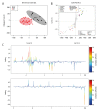Proton Nuclear Magnetic Resonance (¹H-NMR)-Based Metabolomic Evaluation of Human Renal Allografts from Donations After Circulatory Death
- PMID: 29149095
- PMCID: PMC5702106
- DOI: 10.12659/msm.905168
Proton Nuclear Magnetic Resonance (¹H-NMR)-Based Metabolomic Evaluation of Human Renal Allografts from Donations After Circulatory Death
Abstract
BACKGROUND Delayed graft function (DGF) is a common complication that impairs allograft function after kidney transplantation. However, the mechanism of DGF remains unclear. Nuclear magnetic resonance (NMR)-based analysis has been widely used in recent times to assess changes in metabolite levels. MATERIAL AND METHODS Samples of perfusate from allografts donated after circulatory death were collected prior to transplantation, during static cold storage. ¹H-NMR-based metabolomics combined with the statistical methods, orthogonal partial least-squares discriminant analysis (OPLS-DA), and principle-component analysis (PCA), were employed to test different levels of metabolites between the allografts that exhibited DGF and those that exhibited immediate graft function (IGF). RESULTS The study population consisted of 36 subjects, 11 with DGF and 25 with IGF. Of the 37 detected and identified metabolites, a-glucose and citrate were significantly elevated in the perfusate of DGF allografts, and taurine and betaine were significantly decreased. CONCLUSIONS ¹H-NMR analysis of DGF and IGF perfusates revealed some significant differences in their metabolite profiles, which may help explain the mechanisms of kidney ischemia-reperfusion injury and DGF.
Conflict of interest statement
None.
Figures


Similar articles
-
Metabolomic analysis of perfusate during hypothermic machine perfusion of human cadaveric kidneys.Transplantation. 2015 Apr;99(4):754-9. doi: 10.1097/TP.0000000000000398. Transplantation. 2015. PMID: 25222017
-
Untargeted NMR-based metabolomics analysis of kidney allograft perfusates identifies a signature of delayed graft function.Metabolomics. 2024 Mar 9;20(2):39. doi: 10.1007/s11306-024-02106-1. Metabolomics. 2024. PMID: 38460018
-
Functional MRI detects perfusion impairment in renal allografts with delayed graft function.Am J Physiol Renal Physiol. 2015 Jun 15;308(12):F1444-51. doi: 10.1152/ajprenal.00064.2015. Epub 2015 Apr 29. Am J Physiol Renal Physiol. 2015. PMID: 25925250
-
Delayed graft function and its management in children.Pediatr Nephrol. 2017 Jul;32(7):1157-1167. doi: 10.1007/s00467-016-3528-9. Epub 2016 Oct 24. Pediatr Nephrol. 2017. PMID: 27778091 Review.
-
Neutrophil Gelatinase-Associated Lipocalin as a Biomarker of Allograft Function After Renal Transplantation: Evaluation of the Current Status and Future Insights.Artif Organs. 2018 Jan;42(1):8-14. doi: 10.1111/aor.13039. Epub 2017 Dec 20. Artif Organs. 2018. PMID: 29266311 Free PMC article. Review.
Cited by
-
Artificial Intelligence Algorithm-Based MRI in the Diagnosis of Complications after Renal Transplantation.Contrast Media Mol Imaging. 2022 Aug 16;2022:8930584. doi: 10.1155/2022/8930584. eCollection 2022. Contrast Media Mol Imaging. 2022. PMID: 36072641 Free PMC article.
-
Exploring the role of metabolomics in kidney transplantation: a systematic review of the literature.Front Immunol. 2025 Jun 10;16:1534875. doi: 10.3389/fimmu.2025.1534875. eCollection 2025. Front Immunol. 2025. PMID: 40557166 Free PMC article.
-
Multi-omics Approach in Kidney Transplant: Lessons Learned from COVID-19 Pandemic.Curr Transplant Rep. 2023 Dec;10(4):173-187. doi: 10.1007/s40472-023-00410-8. Epub 2023 Aug 23. Curr Transplant Rep. 2023. PMID: 38152593 Free PMC article.
-
A Review of Current and Emerging Trends in Donor Graft-Quality Assessment Techniques.J Clin Med. 2022 Jan 18;11(3):487. doi: 10.3390/jcm11030487. J Clin Med. 2022. PMID: 35159939 Free PMC article. Review.
References
-
- Tugmen C, Sert I, Kebabci E, et al. Delayed graft function in kidney transplantation: Risk factors and impact on early graft function. Prog Transplant. 2016;26(2):172–77. - PubMed
-
- Troppmann C, Gillingham KJ, Benedetti E, et al. Delayed graft function, acute rejection, and outcome after cadaver renal transplantation. The multivariate analysis. Transplantation. 1995;59(7):962–68. - PubMed
-
- Yarlagadda SG, Coca SG, Formica RN, Jr, et al. Association between delayed graft function and allograft and patient survival: A systematic review and meta-analysis. Nephrol Dial Transplant. 2009;24(3):1039–47. - PubMed
-
- Tahir W, Hakeem A, Dawrant M, et al. Early sirolimus conversion as rescue therapy in kidneys with prolonged delayed graft function in deceased donor renal transplant. Transplant Proc. 2015;47(6):1610–15. - PubMed
-
- Ludwig C, Ward DG, Martin A, et al. Fast targeted multidimensional NMR metabolomics of colorectal cancer. Magn Reson Chem. 2009;47(Suppl 1):S68–73. - PubMed
MeSH terms
Substances
LinkOut - more resources
Full Text Sources

